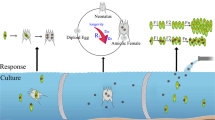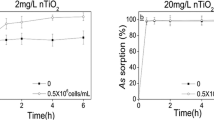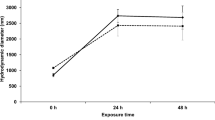Abstract
The recent increase in nanomaterial usage has led to concerns surrounding its health risks and environmental impact. The food chain is an important pathway for high-trophic-level organisms absorbing and enriching nanomaterials. Our study therefore simulated nanometer titanium dioxide (nano-TiO2) transfer along a 2-step food chain, from the unicellular alga Scenedesmus obliquus to the water flea Daphnia magna. We also explored the effect of sodium dodecyl benzene sulfonate (SDBS) on nano-TiO2 bioavailability. A suspension of 10 mg/L nano-TiO2 was optimally dispersed in aqueous solutions by 5 mg/L SDBS. After 72 h, S. obliquus growth was not significantly affected by 10 mg/L nano-TiO2, 5 mg/L SDBS and their mixed suspension. SDBS not only improved nano-TiO2 stability in water, but also increased its uptake in S. obliquus and enhanced its accumulation in D. magna. Our study suggests that nano-TiO2 is mildly toxic to S. obliquus, and can be transferred along the aquatic food chain with a biomagnification effect.
Similar content being viewed by others
Explore related subjects
Discover the latest articles, news and stories from top researchers in related subjects.Avoid common mistakes on your manuscript.
The nanotechnology industry has been rapidly developing since the 1990s. Nanometer titanium dioxide (Nano-TiO2) has become one of the most important nanometer-sized materials due to its hydrophilic and photocatalytic properties, and its capacity to absorb ultraviolet light (Nel et al. 2006). Nano-TiO2 have been widely used in the fields of painting, paper making, wastewater treatment, sterilization, solar cells, food additives and cosmetics industries, which are closely related to our daily life (Wang et al. 2008). However, through industrial production, transportation and trading, nano-TiO2 can be released into the atmosphere, soil and water, ultimately harming the environment and inhabiting organisms (Farré et al. 2008; Behrens 2011).
The environmental and biological effects of nano-TiO2 have caused widespread concern, and much attention was focused on the effects of nanomaterials on organisms in the aquatic system (Hund-Rinke and Simon 2006; Heinlaan et al. 2008; Zhu et al. 2008; Strigul et al. 2009). However, very little is known about the dietary intake of food-associated nanoparticles. Cedervall et al. (2012) reported that commercially manufactured polystyrene nanoparticles were transferred along an aquatic food chain from algae, through zooplankton to fish. Another study reported that Danio rerio fed with Daphnia magna, which were exposed to nano-TiO2 accumulated more nano-TiO2 than Danio rerio exposed to the same amount of nano-TiO2 in water (Zhu et al. 2010). These pioneering studies indicated that the food chain serves as an important pathway for high-trophic-level organisms absorbing and enriching nanomaterials. To our knowledge, little work has been carried out to explore whether the food chain transmission and accumulation from Scenedesmus obliquus to D. magna can occur after a long period of exposure to nanoparticles.
Nanomaterials can absorb heavy metals, surfactants, and other pollutants in water owing to their small size, large specific surface area, high surface energy, and strong adsorption ability (Wehmeyer et al. 2010; Wang et al. 2007). Thus, the effects of pollutants in water should be taken into account when the toxicity and accumulation of nanoparticles in organisms are being assessed (Kim et al. 2013; Wang et al. 2011). Sodium dodecyl benzene sulfonate (SDBS) is an anionic surfactant that is used to disperse and stabilize engineered nanoparticles. Godinez and Darnault (2011) found that the presence of SDBS enhanced the transportion of nano-TiO2 in saturated porous media. However, little is known about the effect of SDBS on the bioavailability of nano-TiO2. Thus, in this study, we chose the unicellular alga S. obliquus and the water flea D. magna as test organisms and fed D. magna with S. obliquus that were exposed to a nano-TiO2 and nano-TiO2-SDBS mixture for 35 days. Concentrations of Ti in S. obliquus and D. magna were measured to study the transmission and accumulation of nano-TiO2 in this food chain.
Materials and Methods
Nano-TiO2 with a particle size of 21 nm and surface area of 50 m2/g were obtained from Guangzhou Huali Senmao Co., Ltd. (Guangzhou, China). The ratio of anatase to rutile titanium in these particles is approximately 80:20. A 500 mg/L stock solution of nano-TiO2 was prepared by dispersing the nanoparticles in algal culture medium with sonication for 20 min at 40 kHz. The actual Ti concentration of stock solution determined by inductively coupled plasma-mass spectrometry (ICP-MS, Agiligent-7500 a, CA, USA) was 493 ± 8.10 mg/L. Detection limit of the ICP-MS for Ti was 0.1 μg/L. Standard solutions were freshly prepared, and standard calibration curves with r 2 > 0.995 were achieved. Particle size distributions of nTiO2 aggregates at 72 h were determined using a dynamic light scattering device (DLS, 380ZLS, NY, USA).
SDBS was purchased from the Shanghai Pure Reagent Co., Ltd. (Shanghai, China). A 100 mg/L stock solution of SDBS was prepared by dispersing the SDBS in algal culture medium with sonication for 20 min at 40 kHz. The nominal stock concentration was diluted to 3 mg/L and the actual SDBS concentration determined by anionic surfactant (SDBS) concentration meter (HI 96769, Shanghai, China) was 2.9 ± 0.35 mg/L, corresponding to 96.7 % of the nominal stock concentration.
Scenedesmus obliquus was purchased from Wuhan Hydrobiology, China Academy of Sciences. The algal medium used was the 4th (HB-4) aquatic artificial culture medium, as stipulated by the China State Environmental Protection Bureau Guidelines 201(ISO 8692, OECD 201, DIN 38412-33), which was composed of ultra-pure water (Millipore Ultra-water system) and the following chemicals (mg/L): NaNO3 500.00, CaCl2·2H2O 25.00, MgSO4·7H2O 75.00, K2HPO4 75.00, KH2PO4 175.00, NaCl 25.00, EDTA-Na 25.00, KOH 25.50, FeSO4·7H2O 7.37, H3BO3 11.42, ZnSO4·7H2O 8.82 × 10−3, MnCl2·4H2O 1.44 × 10−3, MoO3 7.10 × 10−3, CuSO4·5H2O 1.57 × 10−3, Co(NO3)·6H2O 4.90 × 10−3. The medium was placed in an illumination incubator (PQX-330A-22H, Sichuan, China) under the following conditions: temperature = 25 ± 1°C, light intensity = 3500 lux, humidity = 70 %, 14:10 h light: dark cycle.
Daphnia magna was provided by Zhejiang University and cultured in M4 medium at 20 ± 2°C, 70 % humidity and a 16:8 h light: dark cycle under 3000 lux (OECD 2004). The algae solution contains about 40 mg-C/L. Therefore, each daphnia was daily fed with 5 mL algae solution and the water was changed three times a week.
To determine the influence of surfactant SDBS on nano-TiO2 dispersion, 2 mL nano-TiO2 stock liquid with 0, 2, 5, 10 and 15 mL SDBS reserve liquid were dispensed into 100 mL volumetric flasks to ensure a final nano-TiO2 concentration of 10 mg/L and final SDBS concentrations of 0, 2, 5, 10, and 15 mg/L. The suspensions were sonicated for 20 min, and the absorbance was determined at 325 nm using the ultraviolet spectrophotometer (SP-2102UVPC, Shenzhen, China).
Because SDBS affects the dispersion of nano-TiO2 in water (Ma 1985), it may also affect the bioavailability of nano-TiO2. We therefore investigated the impact of a system containing both SBDS and nano-TiO2 on the growth of S. obliquus. The concentration of nano-TiO2 and SDBS were 10 and 5 mg/L, respectively. After 72 h, the content of chlorophyll a in algae was measured at 663 nm by ultraviolet spectrophotometer (SP-2102UVPC, Shenzhen, China) as previously described (Lichtenthaler and Wellburn 1983).
The food chain test was evaluated for three groups i.e. the control group, the nano-TiO2 group and the nano-TiO2-SDBS group. The algae were exposed to 10 mg/L nano-TiO2 fluid (in the nano-TiO2 system), 10 mg/L nano-TiO2 and 5 mg/L SDBS (in the nano-TiO2-SDBS system). Each group was set up in triplicates. After 72 h, 10 mL algal liquid, which was taken from the test vessels, was repeatedly flushed with ultrapure water, concentrated by centrifuging at 3850×g for 10 min, and fed to D. magna. Simultaneously, 10 mL algal fluid was collected for determining the nano-TiO2 content in S. obliquus by ICP-MS. Each 100 mL beaker contained 50 mL D. magna nutrient solution and 10 young fleas (6–24 h old). Each daphnia was fed with 5 mL algae solution even during the final assay and a new nutrient solution was prepared twice weekly. The experiment was conducted over 35 days. Fifty daphnias were taken from each treatment to evaluate the nano-TiO2 content at 7-day intervals. The daphnias samples were rinsed repeatedly by ultrapure water to remove the Ti that absorbed on their surface, then dried to a constant weight, digested by concentrated nitric acid and determined the Ti content by ICP-MS. To analyze the food chain transfer of nano-TiO2 from S. obliquus to D. magna, a biomagnification factor (BMF) was calculated as the ratio of the nano-TiO2 concentration in D. magna (mg kg−1) to that in its diet of S. obliquus at steady state (Arnot and Gobas 2006).
Results are presented as the mean ± SD (standard deviation) of triplicate treatments. The statistical analysis was performed by the program Origin7.5 using one-way analysis of variance (ANOVA). The differences among the groups were compared by the Newman–Keuls method. Differences were considered statistical significant at p < 0.05.
Results and Discussion
In our previous study (Xin 2012), we found that there were large aggregates formed in nano-TiO2 suspension. However, these aggregates were still in the nanoscale. What is more, Fig. 1 shows the actual mean particle diameter in the stock solution were found to be 250.5 (with range 30.6–4164.7) nm after their addition to the culture medium for 72 h.
Nano-TiO2 possesses special physicochemical properties that facilitate aggregation in aqueous environments. In practical application, the surface of the suspended nano-TiO2 is often modified by surfactants, which can strengthen particle dissolution and control the particle size, promote uniform dispersal in the water (Shan et al. 2006). Figure 2 shows the effect of SDBS on nano-TiO2 (10 mg/L) dispersion. The absorbance of the TiO2 nanoparticles gradually increases with the increasing concentration of SDBS (0–5 mg/L), indicating that SDBS improves the dispersion properties of nano-TiO2 and strengthens its stability in water. SDBS is an anionic surfactant and nano-TiO2 particles present negative charge in water. Nano-TiO2 can absorb SDBS and produce a lot of negative charge on the surface, then form double electric layer, producing repulsive force between particles by increase in zeta potential (Ma 1985). Thus, large aggregates are not easily formed and the nano-TiO2 stabilizes in water. However, once the SDBS concentration exceeded 5 mg/L, the absorbance presents as a decreasing function of SDBS concentration. Thus, the nano-TiO2 is optimally dispersed in aqueous solutions containing about 5 mg/L SDBS, which was consistent with the results of our previous work (Chen et al. 2013).
Algae are the primary producers in aquatic environments, and their growth inhibition can reflect the effects of pollutants (Ji et al. 2011). The chlorophyll a content is often used to estimate the biomass of algae, and its response to environmental stress (Zhang et al. 2011). Although several studies have investigated the toxicity of nano-TiO2 (Aruoja 2009) and SDBS (Zelimira et al. 2005) on algae, studies of the joint toxicity of both compounds are scarce. After 72 h, the chlorophyll a content of S. obliquus which exposed to nano-TiO2, SDBS, and their mix solution are presented in Fig. 3. Compared to the control group, the p values of nano-TiO2 group, SDBS group and nano-TiO2-SDBS group were 0.187, 0.151 and 0.169, respectively. It indicated that 10 mg/L nano-TiO2, 5 mg/L SDBS and their mixed solution exerted no significant effect on the growth of S. obliquus. Similarly, the coexistence of SDBS and nano-TiO2 exhibited no joint toxicity on the chlorophyll a content of the algae.
Because D. magna is a filter feeder in water, it inevitably takes in contaminants along with its food. As shown in Fig. 4, nano-TiO2 was found in D. magna while feeding off S. obliquus exposed to 10 mg/L nano-TiO2, confirming that a transfer across the borders of these two specific trophic levels seem to occur as reported earlier by Bouldin et al. (2008). Nanoparticles accumulated rapidly in D. magna after first week exposure from its food, but declined between days 14 and 21 and stayed at relatively stable state afterwards. Moreover, the addition of SDBS made the maximum enrichment of nano-TiO2 in the D. magna increased from 90.12 ± 3.10 to 158.33 ± 3.51 mg/kg. It indicated that SDBS can affect the bioavailability of nano-TiO2, and proved that the surfactant in water also should be taken into consideration when we evaluate the toxicity of nanoparticles. As shown in Table 1, D. magna accumulated nano-TiO2 to a greater extent than S. obliquus. The results showed that the biomagnification factor (BMF) of nano-TiO2 exceeded 1, indicating that biomagnification of nano-TiO2 from S. obliquus to D. magna may occur through dietary exposure. The similar biological amplification phenomenon has been found in persistent organic pollutants (POPs) from zooplankton to fish in the ecosystem of Long Island Sound (Mader 1996). Further, the amount of nano-TiO2 that accumulated in S. obliquus and D. magna was enhanced with the presence of SDBS, i.e. from 15.46 ± 1.28 to 59.51 ± 2.16 mg/kg and 90.12 ± 3.10 to 158.33 ± 3.51 mg/kg, respectively.
In summary, this study provides the first direct evidence for nano-TiO2 transfer from S. obliquus to D. magna with biomagnification in a simplified food chain, indicating that food webs in surface waters may receive high loads of nanoparticles. The results also demonstrated that SDBS can strengthen the dispersion of nano-TiO2 in water and increase the accumulation of nano-TiO2 in organisms. Hence, it is more realistic to take SDBS into account to assess the toxicity of nanoparticles. However, the effect of SDBS on the bioavailability of nano-TiO2 is still not clear. Further research is also required to explore the factors that influence the transfer and biomagnifications in food chain.
References
Arnot JA, Gobas FAPC (2006) A review of bioconcentration factor (BCF) and bioaccumulation factor (BAF) assessments for organic chemicals in aquatic organisms. Environ Rev 14:257–297
Aruoja V (2009) Toxicity of nanoparticles of CuO, ZnO and TiO2 to microalgae Pseudokirchneriella subcapitata. Sci Total Environ 407(4):1461–1468
Behrens S (2011) Preparation of functional magnetic nanocomposites and hybrid materials: recent progress and future directions. Nanoscale 3(3):887–892
Bouldin JL, Ingle TM, Sengupta A (2008) Aqueous toxicity and food chain transfer of quantum dots (TM) in freshwater algae and Ceriodaphnia dubia. Environ Toxicol Chem 27(9):1958–1963
Cedervall T, Hansson L-A, Lard M, Frohm B, Linse S (2012) Food chain transport of nanoparticles affects behavior and fat metabolism in fish. PLoS One 7(2):1–6
Chen JY, Fang JF, Wei XZ (2013) Studies on the dispersion and deposition behavior of nano-TiO2 in aquatic system. Environ Sci 34(10):207–213
Farré M, Gajda-Schrantz K, Kantiani L (2008) Ecotoxicity and analysis of nanomaterials in the aquatic environment. Anal Bioanal Chem 393(1):81–95
Godinez IG, Darnault CJ (2011) Aggregation and transport of nano-TiO2 in saturated porous media: effects of pH, surfactants and flow velocity. Water Res 45(2):839–851
Heinlaan M, Ivask A, Blinova I (2008) Toxicity of nanosized and bulk ZnO, Cu and TiO2 to bacteria Vibrio fischeri and crustaceans Daphnia magna and Thamnocephalus platyurus. Chemosphere 71(7):1308–1316
Hund-Rinke K, Simon M (2006) Ecotoxic effect of photocatalytic active nanoparticles TiO2 on algae and daphnias. Environ Sci Pollut Res 13(4):225–232
Ji J, Long ZF, Lin DH (2011) Toxicity of oxide nanoparticles to the green algae Chlorella sp. Chem Eng J 170:525–530
Kim JY, Kim KT, Lee BG (2013) Developmental toxicity of Japanese medaka embryos by silver nanoparticles and released ions in the presence of humic acid. Ecotoxicol Environ Saf 92:57–63
Lichtenthaler HK, Wellburn AR (1983) Determinations of total carotenoids and chlorophylls a and b of leaf extracts in different solvents. Biochem Soc Trans 11:591–592
Ma C (1985) Adsorption from mixed solution of poly (vinylpyrro lidone) and sodium dodecyl sulfate on titanium dioxide. Colloids Surf A 16:185
Mader SS (1996) Biology, 5th edn. Wm. C. Brown Publishers, Dubuque
Nel A, Xia T, Madler L (2006) Toxic potential of materials at the nanolevel. Science 311(5761):622–627
Shan FJ, Gao J, Jia WD (2006) Study on the dispersion of nanometer TiO2 powder by Sol–Gel method. Chem Eng 34(1):52–54
Strigul N, Vaccari L, Galdun C (2009) Acute toxicity of boron, titanium dioxide and aluminum nanoparticles to Daphnia magna and Vibrio fischeri. Desalination 248(1–3):771–782
Wang MH, Woo KD, Kim IY (2007) Separation of Fe3+ during hydrolysis of TiO2+ by addition of EDTA. Hydrometallurgy 89(3–4):319–322
Wang JX, Li W, Liu Y (2008) Environmental health and ecological toxicology effect of titanium dioxide nanometer materials. Ecol Toxicol J 3(2):105–113
Wang Z, Li J, Zhao J (2011) Toxicity and internalization of CuO nanoparticles to prokaryotic alga Microcystis aeruginosa affected by dissolved organic matter. Environ Sci Technol 45(14):6032–6040
Wehmeyer JL, Synowicki R, Bizios R (2010) Dynamic adsorption of albumin on nanostructured TiO2 thin films. Mater Sci Eng 30(2):277–282
Xin YY (2012) Study on aquatic biological toxicology of titanium dioxide nanoparticles. Zhejiang university of technology, Zhejiang, pp 27–28
Xin YY, Chen JY, Cheng YH (2013) Ecological effects of nano-TiO2 and heavy metal Cd on M. aeruginosa. Asian J Ecotoxicol 8(1):23–28
Zelimira P, Zeljka V, Dinko P (2005) Toxicity of surfactants to green microalgae Pseudokirchneriella. Chemosphere 61:1061–1068
Zhang N, Jin XL, Li X (2011) Progress of toxic effects of artificial nano-materials on alga. J Anhui Agric Sci 39(10):6000–6003
Zhu MT, Feng WY, Wang B (2008) Comparative study of pulmonary responses to nano- and submicron-sized ferric oxide in rats. Toxicology 247(2–3):102–111
Zhu XS, Wang JX, Zhang XZ (2010) Trophic transfer of TiO2 nanoparticles from daphnia to zebrafish in a simplified freshwater food chain. Chemosphere 79(9):928–933
Acknowledgments
This work was supported by the National Natural Science Fund project [21177114], China.
Author information
Authors and Affiliations
Corresponding author
Rights and permissions
About this article
Cite this article
Chen, J., Li, H., Han, X. et al. Transmission and Accumulation of Nano-TiO2 in a 2-Step Food Chain (Scenedesmus obliquus to Daphnia magna). Bull Environ Contam Toxicol 95, 145–149 (2015). https://doi.org/10.1007/s00128-015-1580-y
Received:
Accepted:
Published:
Issue Date:
DOI: https://doi.org/10.1007/s00128-015-1580-y








